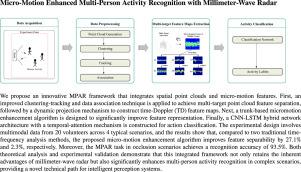Micro-motion enhanced multi-person activity recognition with millimeter-wave radar
IF 5.6
2区 工程技术
Q1 ENGINEERING, MULTIDISCIPLINARY
引用次数: 0
Abstract
As a non-contact sensing device, millimeter-wave radar exhibits unique strengths in human activity recognition (HAR). Existing methods rely on micro-Doppler signatures for activity classification, but they often encounter feature aliasing in multi-person activity recognition (MPAR) scenarios. Although point cloud-based approaches can distinguish individual targets, they primarily extract static morphological features, neglecting the micro-motion information of human joints, which is crucial for accurate activity recognition. To address these limitations, we proposes an innovative MPAR framework that integrates spatial point clouds and micro-motion features. First, an improved point cloud data association algorithm is applied to achieve multi-target point cloud feature separation, followed by a dynamic projection mechanism to construct time–Doppler feature maps. Then, a torso micro-motion enhancement algorithm is designed to enhance the details of human body movements. Finally, a CNN-LSTM hybrid network architecture with a temporal-attention is constructed for action classification. Experimental results show that the proposed micro-motion enhancement algorithm improves recognition accuracy by 27.1% and 2.3%, compared to two traditional time–frequency analysis methods. Furthermore, MPAR task in occlusion scenarios achieves recognition accuracy of 93.5%. In summary, proposed framework not only retains the inherent advantages of millimeter-wave radar but also significantly enhances multi-person activity recognition in complex scenarios.

微运动增强了毫米波雷达对多人活动的识别
毫米波雷达作为一种非接触式传感设备,在人体活动识别方面具有独特的优势。现有方法依赖于微多普勒特征进行活动分类,但在多人活动识别(MPAR)场景中经常遇到特征混叠问题。虽然基于点云的方法可以区分单个目标,但它们主要提取静态形态特征,忽略了人体关节的微运动信息,而这对于准确识别活动至关重要。为了解决这些限制,我们提出了一个创新的MPAR框架,该框架集成了空间点云和微运动特征。首先,采用改进的点云数据关联算法实现多目标点云特征分离,然后采用动态投影机制构建时间-多普勒特征图。然后,设计了躯干微运动增强算法,增强人体运动的细节。最后,构造了一种具有时间-注意力的CNN-LSTM混合网络结构,用于动作分类。实验结果表明,与两种传统时频分析方法相比,提出的微运动增强算法的识别准确率分别提高了27.1%和2.3%。遮挡场景下MPAR任务的识别准确率达到93.5%。综上所述,该框架不仅保留了毫米波雷达的固有优势,而且显著提高了复杂场景下的多人活动识别能力。
本文章由计算机程序翻译,如有差异,请以英文原文为准。
求助全文
约1分钟内获得全文
求助全文
来源期刊

Measurement
工程技术-工程:综合
CiteScore
10.20
自引率
12.50%
发文量
1589
审稿时长
12.1 months
期刊介绍:
Contributions are invited on novel achievements in all fields of measurement and instrumentation science and technology. Authors are encouraged to submit novel material, whose ultimate goal is an advancement in the state of the art of: measurement and metrology fundamentals, sensors, measurement instruments, measurement and estimation techniques, measurement data processing and fusion algorithms, evaluation procedures and methodologies for plants and industrial processes, performance analysis of systems, processes and algorithms, mathematical models for measurement-oriented purposes, distributed measurement systems in a connected world.
 求助内容:
求助内容: 应助结果提醒方式:
应助结果提醒方式:


